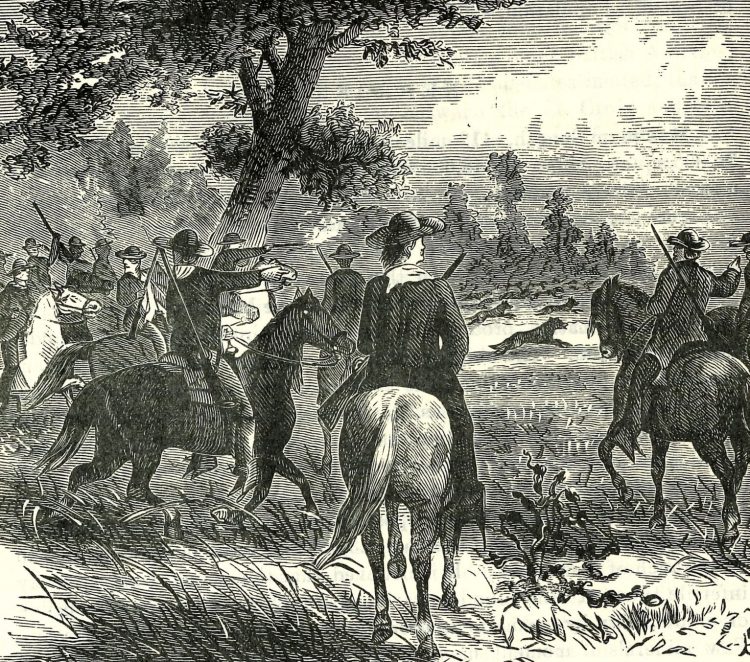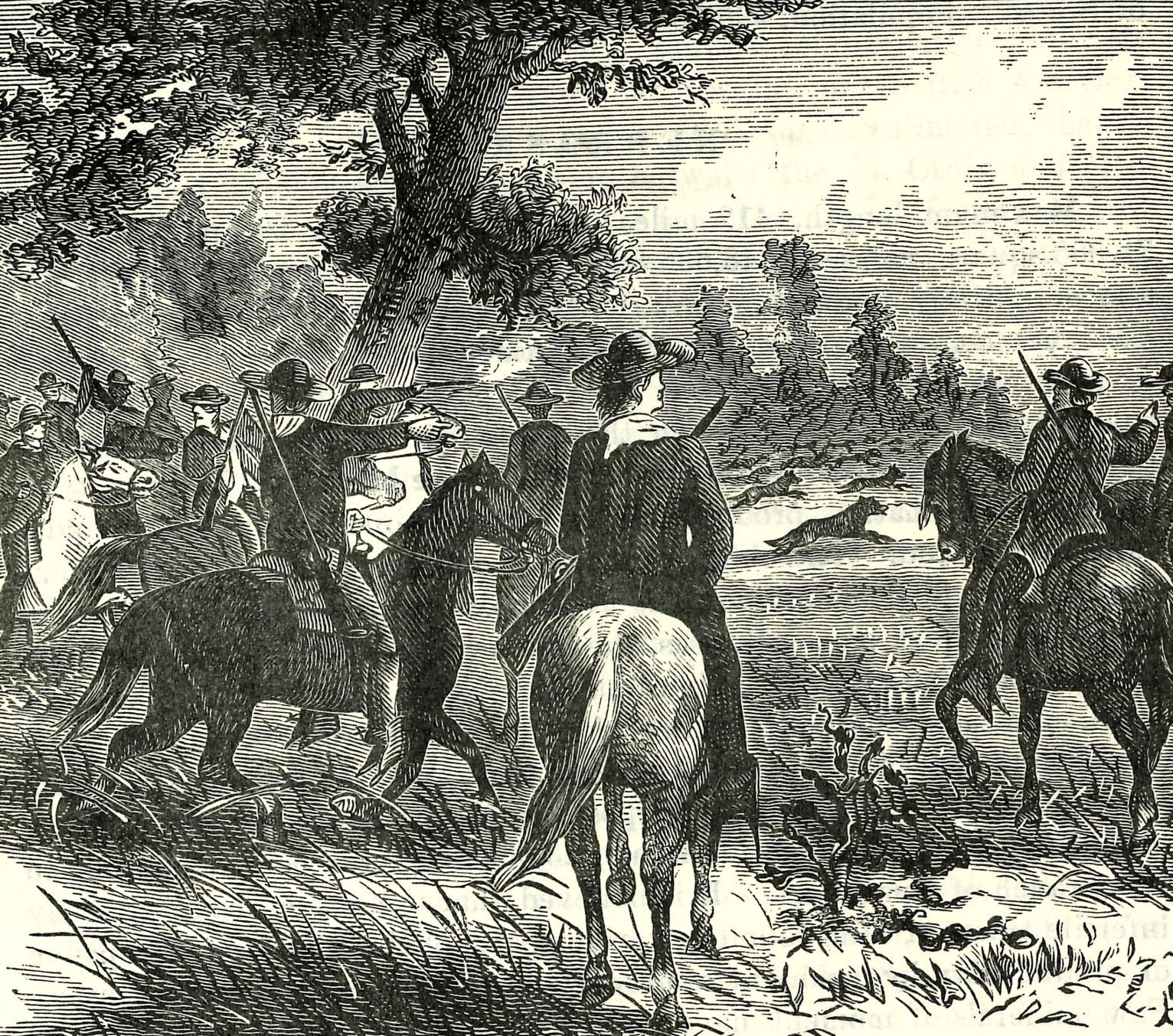
In the spring of 1830, Ephraim Scudder Myers settled near the large timbered tract in eastern McLean County known as Cheney’s Grove. Like most of his pioneer neighbors, he waged a pitiless war of extermination against the wolf.
“Mr. Myers formerly kept seven hounds to hunt wolves and gave them plenty of business,” reads his biographical sketch in a history of McLean County pioneers. “But in the year 1850 the people all turned out for a grand hunt, and went after the wolves in their dens, before the little wolf puppies were large enough to come out, and killed 30 in two days, and after that they were never so troublesome.”
Indeed, dens left unattended while adult wolves were off hunting presented easy pickings for hunters. Jacob Bishop, who eventually settled in Randolph Township in southern McLean County, once “dug out a den and found five little wolf puppies. The old ones were looking on in the distance, but did not dare to come up.” Such was the character of this merciless campaign against Canis lupus.
Wolves were but one of countless species that staggered and then fell before the onslaught of Euro-American settlement in Central Illinois. Indigenous mammals as dissimilar as the prairie chicken and black bear were hunted for food and sport, and they too were removed from their homeland, never to return. Wolves faced a similar fate, though they provoked an unmatched level of contempt and cruelty, and this in an era when violence toward the natural landscape and the creatures upon it was near universal.
Early McLean County settler William Crose, who “had great sport with wolves,” attempted to tame a captured wolf so he could lead it like a domesticated dog. “He tied a chain to its neck and fastened the other end of the chain to his wagon, but the wolf would allow itself to be dragged for miles without walking.” Alfred Stringfield dragged a captured wolf home, and after keeping it a week he had his dogs maul it to death at his mother’s quilting bee.
Wolves have long been associated with sin and the supernatural, and wolf hatred was deeply ingrained in Euro-American culture. Even modern perceptions of wolves are tinged with the bedtime stories of youth, and our unwarranted fear of wolves is more a reflection of legend and lore than the hard science of wolf biology and behavior. That said, if anything doomed Canis lupus in Central Illinois, it was pioneer’s ferocious defense of livestock, as wolves naturally turned to the relatively slow-footed and defenseless newcomers such as sheep, hogs and calves.
At this time, the coyote, Canis latrans, was also called a wolf, so sometimes it’s uncertain if pioneers were referring to a wolf proper or its smaller relative. Fortunately, they often employed descriptive vernacular terms that differentiated the two species. One can be reasonably certain that talk of “large,” “big,” “gray” (sometimes spelled “grey”), or “timber” wolves usually meant true wolves. On the other hand, “prairie wolf” was a common term for what’s today called a coyote.
At various times and with varying degrees of success, government officials encouraged the killing of wolves and other predators through bounty programs. In 1823, the state legislature dangled $200 in prize money to the wolf killer who could produce the most scalps (“with ears entire”). In 1860, McLean County offered a reward of $3 for grown wolf scalps, and 50 cents for wolf pups, with no distinction made between wolves or coyotes.
The preferred method of dispatching wolves was chasing them down on horseback. Once overrun, the animal could be dispatched with a firearm, club, knife, riding stirrup, or simply be trampled to death under hoof. As with all methods of wolf killing, this was anything but a fair fight. When chased to exhaustion, the wolf “crouches on the ground and quietly receives the blow, which kills it,” related a McLean County history published in 1874.
Although pioneer recollections stressed the economic necessity of killing wolves to defend livestock, it is interesting to note the frequent distinction made between hunting and wolf killing as a sport. For instance, Martin Township settler Lytle Royston Wiley, it was said, “was never a hunter but occasionally took amusement by chasing wolves.” Likewise, Stringfield, of Randolph’s Grove, made no boast as to his hunting prowess, but was “sometimes pretty lively in chasing wolves.”
Frequently, dogs were used in horseback chases. William Crose of Money Creek Township “took a great interest in sporting, and kept the finest and fleetest hounds for running wolves and deer.” Based on pioneer accounts, it was not uncommon for these chases to stretch 10 or more miles. Circle or ring hunts were the embodiment of wolf killing as amusement. Participants would employ horns, cowbells and hounds to drive wolves, foxes and other animals into a predetermined killing ground, usually a field marked with a pole and flag.
As with all wolf killing, the danger to hunters was not from the fangs of Canis lupus, but rather from incidental mishaps, for “riding over the prairie at a breakneck pace has dangers sometimes not thought of.” For example, Ebenezer Mitchel was once thrown 20 feet when his horse “plunged into a slough and fell,” and during another chase, the horse of James Rumsey Means broke its neck when it stepped into a badger hole.
Wolves were also trapped in cages and pits, or poisoned with strychnine. William Wilcox was said to have “caught these cunning and treacherous animals in pens, with dogs and horses, and in every way that ingenuity could suggest.” Money Creek settler Samuel Ogden, for one, “never considered it a sin to kill a wolf on Sunday or any other day.”
According to the standard reference work on mammals in Illinois, wolves disappeared from the Prairie State “sometime before 1860.” Yet other sources offer conflicting dates, and small numbers may have survived into the latter decades of the 19th century. Coyotes, though, were never entirely exterminated in Illinois, and the number of “prairie wolves” in McLean County may be greater today than that of the pioneer era.
Source: PFOP: Settlers waged war of extinction against wolves | Local News | pantagraph.com

Comments
Because this is from back east, even though it reads like just about every other historical account of euroamerican wolf persecution (Some date from the 1600s, and describe the circling and driving of wolves and every other native wildlife in areas of Pennsylvania and New England, into a central killing ground.. Others tell of the professional wolfers who poisoned and trapped and shot wolves in the prairie states and Canadian Provinces)
I just want to remind people that the tribes called Mahican in New England, and the Mohegan and Mohican (part of the Lenni Lenape who once occupied Manhattan) were ALL named for Wolf. Even the Mexica (who are called the Azteca) carried this name and relationship down into Mexico, so even Mexico is named for Wolf.
The word still remains the Cree and Algonquian word for Wolf, and the Ojibwa name for Wolf, Ma’iiingan, is pronounced almost exactly like this word.
This name-connection often sprung from the clan form of life, where those who felt most affinity for another being, chose to band together to learn all they could from that being’s way. They also had duties within the community arising from their animal relative’s characteristics. I won’t go further here because there have even been some tribes that took too much from wolf. I have not mentioned such tribes, although their excess leads to the following observation:
There are many human cultures in the world who use poison, and who have learned to take everything, leading to their own demise or dependence upon other nations. This end is what will happen to all who choose that life is only for taking, for getting out of the way.
There is a difference, though:
the small groups that did this thing, have been able to find something else to depend upon, some other humans to do something else for, or to colonize some other way or place to continue to take without sharing or respect for life.
This will not happen any longer. this is why the fighting for place and invention of ways to squeeze between one human endeavor and another, are the only things increasing.
I’ve pursued a lot of science, and can tell you that there will be no colonizing of another planet where people can evacuate the desolated earth they are making. Biological and other issues mentally externalized and ignored, will prevent that fantasy of some kind of ants-eating-everything-and-then-moving-on existence.
Just as the ill history of human persecution and attempts to extinguish the indispensable wolf is a grave mistake, so is the warped shepherding culture that turned the US southwest into land unusable for its former millions: bison and other life, and is turning some of the ocean areas into fishh famrs that are far faster toxifying their areas and species around them. There will be no rocket ticket to heaven; it will be as the Ojibwe say, what is done to the wolf, will also be the fate of the human.
Right now are being designed cities that float on the water, but this will not reduce the pressure that is emptying the earth and the water of other life that has equal right to live. Those of us who have traveled, know that the humans have polluted every water they have heavily occupied around, with or without technology. We have also seen the life-giving water taken from the inhabitants who have formed the great communities of life, all linked together by water.
This taking is arousing political violence, and increasingly, the consequent fearful greed is pervading every human.
Those who understand skill, know that the Way of the Wolf: finding most joy in sharing, suppressing fighting and cautioning the young not to overcompete, requires cessation of fighting, to .survive.
Everyone you will ever meet, will tell you that the wolf is, number one:
amicable.
This wolf- way was imitated by the surviving descendants of the original people who came to this home, since before our kind.
Few know now how much was learned from Wolf, and less follow it.